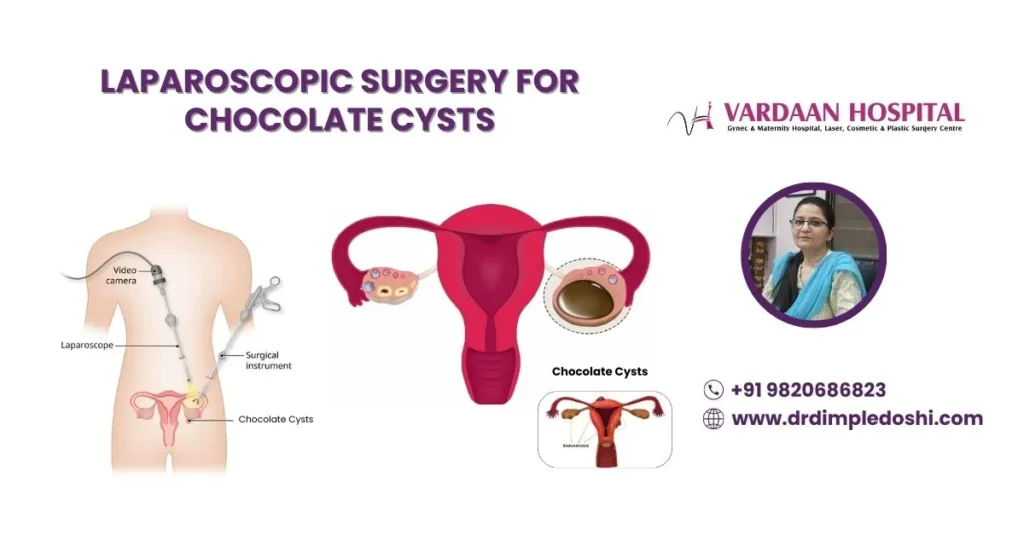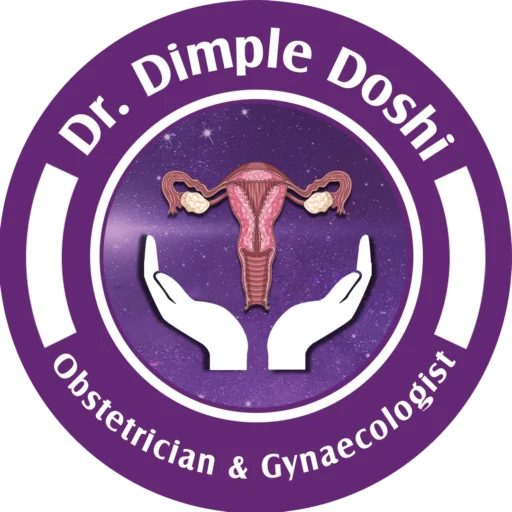
Laparoscopic Surgery for Endometriosis & Chocolate Cysts: Advanced Care for Pain-Free Living
Severe Period Pain or Infertility? It Could Be Endometriosis or Chocolate Cysts
Are you struggling with unbearable menstrual pain, painful intercourse, or difficulty conceiving? These symptoms may indicate endometriosis—a condition where tissue similar to the uterine lining grows outside the uterus. In some cases, it forms chocolate cysts (endometriomas) on the ovaries, which can damage fertility and cause chronic pain.
Ignoring endometriosis can lead to worsening pain, adhesions, and irreversible damage to reproductive organs. For many women, the delay in diagnosis means years of suffering, missed workdays, and emotional distress—impacting not just health but quality of life and relationships.
The good news? Advanced laparoscopic surgery offers a safe and effective solution. This minimally invasive procedure removes endometriotic lesions and chocolate cysts while preserving fertility whenever possible.
At Vardaan Hospital, Dr. Dimple Doshi uses state-of-the-art 3D laparoscopic technology to ensure precision, faster recovery, and reduced recurrence—helping you live pain-free and improve your chances of natural conception.
Why Choose Laparoscopic Surgery for Endometriosis?
- Minimally invasive with small incisions
- Faster recovery and minimal scarring
- Improved pain relief and fertility outcomes
- Lower risk of complications compared to open surgery
What Is Endometriosis and Why Does It Occur?
Endometriosis is a condition where uterine lining tissue grows outside the uterus, causing pain, inflammation, and fertility issues.
- Commonly affects ovaries, fallopian tubes, pelvic lining
- Triggers chronic pain, heavy periods, and adhesions
- Can lead to infertility if untreated
What Are Chocolate Cysts and Why Do They Form?
Chocolate cysts, or ovarian endometriomas, are fluid-filled sacs formed from old menstrual blood trapped in the ovary due to endometriosis.
- Dark brown fluid from old blood gives “chocolate” appearance
- Can cause severe pain and impact ovarian reserve
- Often seen in moderate to severe endometriosis cases
What Happens If Endometriosis Is Left Untreated?
Untreated endometriosis can lead to chronic pain, infertility, adhesions, and even organ damage like bowel or kidney involvement.
- Persistent pelvic pain and painful intercourse
- Severe adhesions causing organ fusion
- Higher risk of infertility and ectopic pregnancy
What Are the Symptoms of Endometriosis and Chocolate Cysts?
Symptoms include severe period pain, painful sex, bloating, chronic fatigue, and infertility in advanced stages.
- Heavy or irregular periods
- Severe dysmenorrhea (period pain)
- Infertility in up to 40% of cases
Why Is Laparoscopic Surgery the Best Treatment for Endometriosis?
Laparoscopy offers high precision, faster recovery, and better fertility outcomes compared to open surgery for endometriosis and cyst removal.
- Small incisions, minimal scarring
- Shorter hospital stay and quick recovery
- Enhanced visualization for accurate excision
How Does Laparoscopic Surgery Treat Endometriosis?
Laparoscopic surgery removes endometriotic implants, adhesions, and nodules while preserving healthy tissue and restoring pelvic anatomy.
- Magnified visualization for complete lesion removal
- Reduces recurrence risk
- Improves pain and fertility outcomes
How Is Laparoscopic Surgery Performed for Chocolate Cysts?
The cyst wall is excised and adhesions released through tiny incisions, ensuring pain relief and lower recurrence risk.
- Drainage of cyst contents
- Removal of cyst wall for long-term relief
- Simultaneous adhesiolysis
Who Is an Ideal Candidate for Laparoscopic Surgery for Endometriosis?
Women with severe pain, infertility, or failed medical management are prime candidates for laparoscopic endometriosis treatment.
- Chronic pelvic pain or dysmenorrhea
- Infertility due to endometriosis
- Endometriomas larger than 4 cm
What Pre-Surgery Preparations Are Required?
Preparation includes medical evaluation, fasting, and medication adjustments to ensure a safe and successful procedure.
- Blood tests and imaging
- Consent and counseling
- Fasting for 6–8 hours before surgery
What Happens During the Laparoscopic Procedure?
Laparoscopic surgery involves inserting a camera and instruments through small incisions to remove lesions and restore anatomy.
- General anesthesia is given
- CO₂ gas inflates the abdomen for visibility
- Excision of implants, nodules, and cysts
What Post-Surgery Care Is Required?
Post-surgery care includes pain management, early mobilization, and wound care for a smooth recovery process.
- Pain medications as prescribed
- Light diet and hydration
- Follow-up in 7–10 days
What Is the Recovery Timeline After Laparoscopic Surgery?
Most women resume light activity in 7–10 days, while complete internal healing takes 6–8 weeks.
- Daycare or 24-hour hospital stay
- Back to light work in 1 week
- Full recovery in 6–8 weeks
What Are the Risks and Complications of Laparoscopic Surgery?
Though rare, risks include bleeding, infection, organ injury, and recurrence of endometriosis.
- Minimal blood loss and low complication rate
- Prevented by expert surgical care
What Is the Cost of Laparoscopic Surgery for Endometriosis in Mumbai?
The cost varies based on complexity and hospital category, ranging from ₹50,000 to ₹2,00,000 at Vardaan Hospital.
- Standard Room: ₹50,000
- Semi-Special Room: ₹68,000–₹75,000
- Deluxe Room: ₹1.2 lakh onwards
Why Choose Dr. Dimple Doshi for Laparoscopic Endometriosis Surgery?
With 25+ years of experience, advanced 3D laparoscopy, and patient-focused care, Dr. Doshi ensures optimal outcomes for endometriosis treatment.
- Expert in complex laparoscopic procedures
- Minimally invasive approach with fertility preservation
Medical Codes for Laparoscopic Surgery for Endometriosis
ICD-10 Codes for Endometriosis & Chocolate Cysts
| ICD-10 Code | Description |
|---|---|
| N80.0 | Endometriosis of uterus |
| N80.1 | Endometriosis of ovary (includes chocolate cysts) |
| N80.2 | Endometriosis of fallopian tube |
| N80.3 | Endometriosis of pelvic peritoneum |
| N80.4 | Endometriosis of rectovaginal septum and vagina |
| N80.8 | Other endometriosis |
| N80.9 | Endometriosis, unspecified |
CPT Codes for Laparoscopic Surgery for Endometriosis & Chocolate Cysts
| CPT Code | Description |
|---|---|
| 49320 | Laparoscopy, diagnostic (peritoneal, omental, or organ biopsy if performed) |
| 58662 | Laparoscopy, surgical; with fulguration or excision of lesions of ovary, pelvic viscera, or peritoneal surface (for endometriosis treatment) |
| 58661 | Laparoscopy, surgical; with removal of adnexal structures (partial or total oophorectomy for severe endometriosis/chocolate cyst) |
| 49329 | Unlisted laparoscopy procedure (if complex or combined procedure) |
| 58925 | Ovarian cystectomy (open approach – used if laparoscopy converted to open surgery) |
FAQs for Laparoscopic Surgery for Endometriosis & Chocolate Cysts
Q1. Can a chocolate cyst be removed without surgery?
Ans. Small cysts may sometimes be managed with hormonal therapy, but surgery is required for larger, symptomatic, or fertility-impacting cysts.Q2. Is chocolate OK for endometriosis?
Ans. Dark chocolate in moderation is generally safe, but processed chocolate high in sugar and dairy may worsen inflammation.Q3. How to remove chocolate cyst naturally?
Ans. No natural method can eliminate a chocolate cyst, though diet and lifestyle changes may help reduce inflammation and symptoms.Q4. What are the risks of chocolate cyst removal surgery?
Ans. Risks include bleeding, infection, damage to surrounding organs, and possible reduction in ovarian reserve if the cyst is large.Q5. Can you get pregnant with endometrioma?
Ans. It’s possible but more challenging; endometriomas can affect egg quality and ovulation, making early treatment important.Q6. How do you remove a cyst from endometriosis?
Ans. Laparoscopic cystectomy is the most common method, which removes the cyst wall to prevent recurrence while preserving ovarian tissue.Q7. How to reduce endometriosis cysts naturally?
Ans. Lifestyle changes like anti-inflammatory diet, stress management, and regular exercise may relieve symptoms but won’t remove cysts.Q8. What is the difference between endometriosis and endometrioma?
Ans. Endometriosis refers to tissue growing outside the uterus, while an endometrioma (chocolate cyst) is a type of ovarian cyst caused by endometriosis.Q9. Can you conceive with a chocolate cyst?
Ans. Yes, but the chances may decrease as cyst size and severity of endometriosis increase, often requiring surgery or IVF for conception.Q10. How long does it take to recover from endometrioma removal?
Ans. Recovery from laparoscopic surgery typically takes 1–2 weeks, with most women returning to normal activities within 7–10 days.Q11. What foods help with endometriosis?
Ans. Anti-inflammatory foods like leafy greens, omega-3-rich fish, and whole grains can help manage symptoms and reduce flare-ups.Q12. Can chocolate cyst resolve on its own?
Ans. No, chocolate cysts rarely resolve naturally and usually require medical or surgical treatment.Q13. Is laparoscopic surgery safe for endometrioma removal?
Ans. Yes, it’s considered safe and is the gold standard for removing endometriomas while minimizing damage to the ovary.Q14. What is the recovery time for endometriosis laparoscopic surgery?
Ans. Most women recover within 1–2 weeks, but complete healing and pain relief may take 4–6 weeks depending on severity.Q15. Can you remove multiple endometriomas laparoscopically?
Ans. Yes, skilled surgeons can remove multiple cysts during the same procedure while preserving as much ovarian tissue as possible.Take charge of your health today.
Book your consultation with Dr. Dimple Doshi at
Vardaan Hospital, Goregaon West, Mumbai.


 WhatsApp
WhatsApp +91-9820686823
+91-9820686823 Book Appointment
Book Appointment